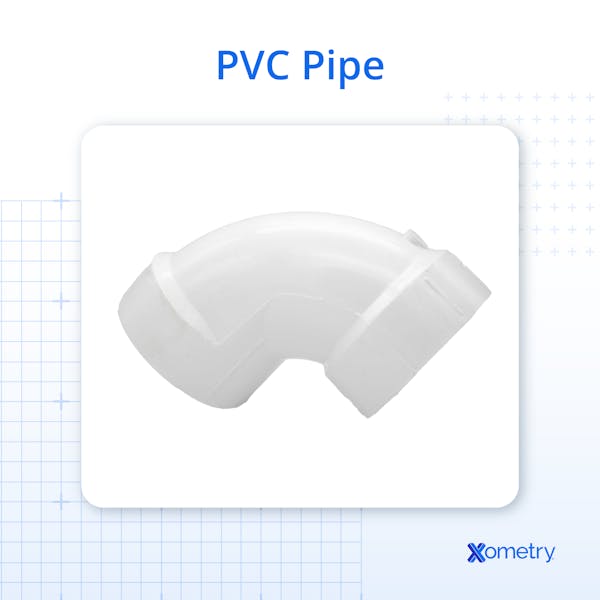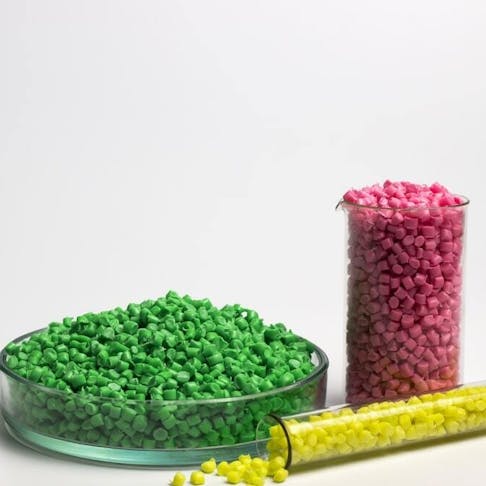Thermoplastic materials are made from polymer chains with repeating monomers. They can be augmented with fillers and stabilizers to further improve their properties. Thermoplastics are among the most widely used manufacturing materials due to their low cost, ease of use, and wide range of properties across the various available grades.
Their wide variety means that specific thermoplastics are well-suited for certain tasks or requirements. For example, one application may demand tough, yet optically transparent polycarbonate while others match better with polypropylene for its toughness, UV resistance, and chemical resistance. This article will explain what thermoplastics are, what they’re made of, and the mechanical properties of some of the more common grades.
What is Thermoplastic?
The term thermoplastic represents a category of plastics that can be softened by heating and hardened by cooling. Unlike thermosetting polymers, thermoplastics can be molded and reshaped multiple times. The ability to form thermoplastics using heat can be appealing for many applications, including construction, consumer goods, and medical devices. Thermoplastics are made up of long chains of molecules called polymers. The three most common thermoplastics are polyethylene, polypropylene, and PVC. Each type of thermoplastic has unique properties that make it suitable for specific uses. Figure 1 below shows a photograph of a PVC pipe:

What Are the Components of Thermoplastic?
Each thermoplastic is made from a base polymer which is often accompanied by pigments, fillers, and stabilizers. The base polymer gives the material its overall mechanical, thermal, and corrosion-resistant properties. Any colors will come from pigments, though transparent and white thermoplastics often contain no pigments. Fillers are used to augment mechanical or thermal properties — for example, glass fiber will improve thermal resistance whereas carbon fiber will improve strength. Stabilizers are added to improve UV resistance, flame resistance, or other functional properties.
What Are the Different Types of Thermoplastic?
There are many different types of thermoplastics. In general, they can be categorized as either commodity or engineering plastics. Commodity plastics are used for a wide range of applications and are the most widely produced plastics due, in part, to their low cost. Engineering plastics are specifically designed for more advanced applications. Table 1 below lists some common materials in each category:
| Thermoplastics | Definition | Characteristics | |
|---|---|---|---|
Thermoplastics Commodity | Definition Polypropylene (PP) | Characteristics Semi-crystalline structure made from polypropylene monomers | Tough, rigid, and corrosion-resistant |
Thermoplastics Commodity | Definition Low-Density Polyethylene (LDPE) | Characteristics Low crystallinity made from ethylene monomers | Tough, flexible, and corrosion resistant |
Thermoplastics Commodity | Definition Polyvinyl Chloride (PVC) | Characteristics Amorphous structure made from vinyl chloride monomers | Impact, water, and chemical resistance. Can be both rigid and flexible. |
Thermoplastics Commodity | Definition High-Density Polyethylene (HDPE) | Characteristics Linear molecular chain of ethylene monomers with increased crystallinity | Tough, rigid, good thermal and chemical resistance |
Thermoplastics Engineering | Definition Polyetheretherketone (PEEK) | Characteristics Semi-crystalline with an aromatic polymer backbone | Excellent chemical, thermal, and abrasion resistance. Excellent mechanical properties |
Thermoplastics Engineering | Definition Polycarbonate (PC) | Characteristics Amorphous structure made from repeating carbonate groups | Very tough, yet as optically clear as glass |
Thermoplastics Engineering | Definition Polyacetal Copolymer (POM-H / Delrin®) | Characteristics Highly crystalline structure made from carbon bonded to two organic functional groups. | Excellent mechanical and thermal properties. |
Thermoplastics Engineering | Definition Polyamide PA (Nylon) | Characteristics Semi-crystalline made from monomers of diamine and an amino acid | Low friction, good UV resistance, good impact and fatigue resistance |
| PP | LDPE | HDPE | PVC | PC | POM-H | PEEK | PA 6 | |
|---|---|---|---|---|---|---|---|---|
PP Density (g/cm3) | LDPE 0.9 | HDPE 0.921 | PVC 0.96 | PC 1.40 | POM-H 1.20 | PEEK 1.42 | PA 6 1.34 | 1.14 |
PP Hardness (Shore D) | LDPE 72 | HDPE 54 | PVC 70 | PC 89 | POM-H 79 | PEEK - | PA 6 85.6 | 77.3 |
PP Ultimate Tensile Strength (MPa) | LDPE 23.4 | HDPE 11.7 | PVC 31.7 | PC 57.6 | POM-H 74 | PEEK 76 | PA 6 98 | 70.2 |
PP Elongation @ Break (%) | LDPE 300 | HDPE 400 | PVC 400 | PC 5 | POM-H 50 | PEEK 45 | PA 6 24.2 | 66.1 |
PP Tensile Modulus (GPa) | LDPE 1.05 | HDPE 0.393 | PVC 1.38 | PC 3.21 | POM-H 2.4 | PEEK 2.9 | PA 6 - | - |
PP Flexural Strength (GPa) | LDPE 33.1 | HDPE - | PVC - | PC - | POM-H - | PEEK 76 | PA 6 156 | 84.9 |
PP Flexural Modulus (GPa) | LDPE 1.24 | HDPE 0.2 | PVC 1.2 | PC 2.74 | POM-H 2.175 | PEEK 2.8 | PA 6 4.41 | 2.34 |
Table Credit: https://www.bing.com/
Where is Thermoplastic Made?
Thermoplastics can be produced using a range of techniques depending on the specific type. The main techniques for thermoplastic synthesis are listed below:
- Transesterification: Used for copolyester elastomers.
- Dynamic vulcanization: Used for thermoplastic vulcanizates.
- Direct copolymerization: Used for TPEs (Thermoplastic elastomers).
- Esterification & polycondensation: Used for polyamides.
- Catalytic copolymerization of olefins: Used for RTPO (reactor thermoplastic polyolefin) plastics.
What Are the Applications for Thermoplastic?
Thermoplastics are used for a wide range of applications due to their ease of manufacture, low cost, and advantageous properties. Listed below is a small sample of the many possible applications of thermoplastics.
- Food containers
- Shopping bags
- Clothing
- Rope
- Consumer goods
- Car bumpers
- Pumps
- Gears
How Strong is Thermoplastic?
Because there are so many types, thermoplastics come in all manner of strength ratings. The specific type, plus the effects of any fillers, will determine the actual strength. Usually, this property is defined by the ultimate tensile strength. Engineering thermoplastics generally have higher strength than others. PEEK, one of the strongest thermoplastics, for example, has an ultimate tensile strength of 98 MPa.
What Are the Advantages of Thermoplastic?
Thermoplastics are popular manufacturing materials. Some of the reasons for this are listed below:
- Ease of Processing: Thermoplastics can be produced with a wide range of technologies like: injection molding, vacuum forming, blow molding, CNC machining, etc.
- Low Cost: Thermoplastics — especially commodity thermoplastics like polypropylene — cost very little per kilogram. The resulting products are thus very affordable, particularly when coupled with high-volume production technologies like injection molding.
- Wide range of properties: Thermoplastics have a wide range of mechanical, thermal, and electrical properties. Specific properties depend on the type of thermoplastic, processing technique, and the types of fillers and additives used.
- High strength-to-weight ratio: Thermoplastics are lightweight. As such, components can be designed to take advantage of this while keeping the loads within acceptable limits. Plastic gears are great examples.
What Are the Disadvantages of Thermoplastic?
Despite their many advantages and widespread adoption, thermoplastics still have some disadvantages, some of which are listed below:
- Unimpressive thermal resistance: Thermoplastics have much lower maximum operating temperatures than metals, so they generally cannot be used in high-temperature applications.
- Susceptible to creep: When exposed to long-term loading conditions, thermoplastics tend to creep over time. Loads must be selected to keep creep within acceptable limits.
- Chemical leaching: Some thermoplastics can leach chemicals over time. This can happen due to pigments, additives, fillers, or the base plastic itself.
- Weakness to ultraviolet: Most thermoplastics will be damaged by exposure to UV radiation. This causes the plastics to become brittle and lose color over time.
What is the Maximum Operating Temperature of Thermoplastic?
Every thermoplastic has its own maximum continuous operating temperature. This property can be further impacted by additives meant to improve thermal stability. The maximum operating temperature of a thermoplastic usually refers to the temperature at which the mechanical properties of the plastic begin to degrade. Table 3 below indicates the maximum operating temperatures of some common thermoplastics:
| Type of Thermoplastic | Max Service Temperature in Air (°C) |
|---|---|
Type of Thermoplastic PP | Max Service Temperature in Air (°C) 82.2 |
Type of Thermoplastic LDPE | Max Service Temperature in Air (°C) 71.1 |
Type of Thermoplastic HDPE | Max Service Temperature in Air (°C) 71.1 |
Type of Thermoplastic PVC | Max Service Temperature in Air (°C) 60 |
Type of Thermoplastic PC | Max Service Temperature in Air (°C) 120 |
Type of Thermoplastic POM-H | Max Service Temperature in Air (°C) 76.9 - 96.9 |
Type of Thermoplastic PEEK | Max Service Temperature in Air (°C) 263 |
Type of Thermoplastic PA 6 | Max Service Temperature in Air (°C) 122 |
Is Thermoplastic Safe to Use?
Yes, thermoplastic is safe to use for many different applications. However, if it is to be used in the presence of food or as part of a medical device, it is important to consult with suppliers to choose a safe grade of the material.
Summary
This article presented thermoplastic, explained whatit is, and discussed the characteristics and types of this material. To learn more about thermoplastic, contact a Xometry representative.
Xometry provides a wide range of manufacturing capabilities and other value-added services for all of your prototyping and production needs. Visit our website to learn more or to request a free, no-obligation quote.
Copyright and Trademark Notices
- Delrin® is a trademark of DuPont de Nemours, Inc.
Disclaimer
The content appearing on this webpage is for informational purposes only. Xometry makes no representation or warranty of any kind, be it expressed or implied, as to the accuracy, completeness, or validity of the information. Any performance parameters, geometric tolerances, specific design features, quality and types of materials, or processes should not be inferred to represent what will be delivered by third-party suppliers or manufacturers through Xometry’s network. Buyers seeking quotes for parts are responsible for defining the specific requirements for those parts. Please refer to our terms and conditions for more information.

